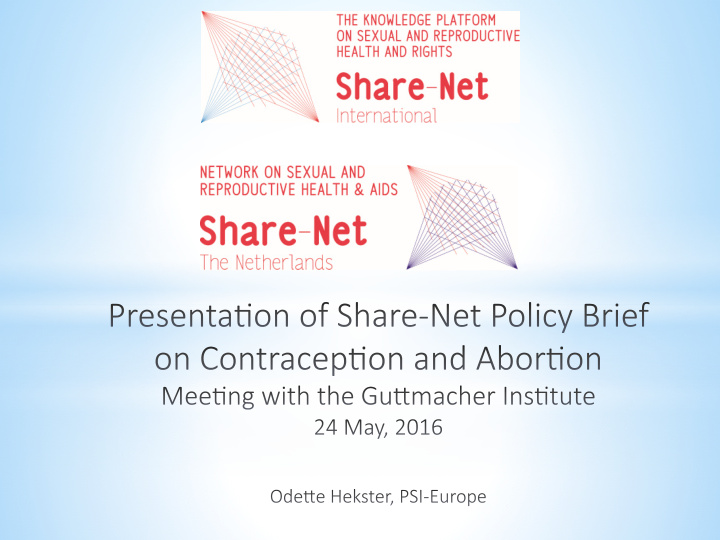



• Introduc)on • The benefits of contracep)on and safe abor)on • Women’s use of and unmet need for contracep)on • Addressing barriers to contracep)ve use • Promising prac)ces to increase access and uptake of contracep)ves and safe abor)on • Recommenda)ons
Cr Cros ossing t the l e line b e between een co contracep)on and abo abor)o r)on n Photo: Heartbeat International
• Both pregnancy and abor)on, the need to control their fer)lity, are part of women’s experience. • Widespread modern contracep)ve use will not completely eliminate the need for abor)on. An es)mated 33 million women worldwide may experience an accidental pregnancy while using contracep)on (WHO, 2012). • Access to emergency contracep)on s)ll restricted in many countries (46 countries have no EC pill brands registered) (ICEC, 2016). Pr Preven)ng un en)ng unwan anted pr ed pregnanc egnancy and pr y and providing sa viding safe abo e abor)o r)ons ar ns are equally e equally imp mportant ways of me mee)ng wome men’s RH needs. Fami mily planning and safe abor)on go hand in hand -> > Crossing the line be betw tween n contr trac acep)o p)on n and and sa safe abo abor)o r)on.. n.. ( Ber Berer er, 2015 2015 ). ). Photo: Heartbeat International
• Contracep)on is key to decreasing the risk of maternal death and morbidity by reducing the # of unintended and high-risk pregnancies.. and – over)me - • The major factor associated with reduced abor)on rates.
• Despite worldwide decrease (43% since 1990), maternal deaths s)ll total 303,000 worldwide (2015). • One sixth of maternal mortality is due to complica)ons of unsafe abor)on, with nearly 50,000 women dying each year. For every maternal death, 20 more women suffer injury, infec)on, or disease related to pregnancy and childbirth. • The unmet need for FP among married women decreased from 15% in 1990 to 12% in 2010 (this excludes unmarried women). S)ll unmet need: 225 million women (2015). • In 2008, an es)mated 3.2 million adolescent women in developing regions underwent unsafe abor)ons. Sources: WHO, 2011, 2014, 2015; Gu6macher Ins<tute, 2014, 2015
• Save Women’s lives: 111,000 maternal deaths in 2015 . • Prevent serious health complica)ons from unsafe abor)on • Beaer child survival • Improve educa)on for women • Reduce public-sector spending on health services • Help to achieve the SDG’s Treatment costs per case of unsafe abortion complications are estimated at $114 for Africa and $130 for Latin For every $1 dollar spent on contraception for 14-19 yrs old, America (WHO, 2012). $17.23 will be saved in preventing unintended pregnancy among adolescent mothers (UNFPA, 2014).
Dispari<es Dispari<es: : • Among regions • Across countries within the same region • Within countries • According to women’s socio economic backgrounds • Urban versus rural
Source: The Millennium Development Goals Report 2015
Dispari)es across countries within same me region..
Wher Where ar e are the se e the sexually ac<v ually ac<ve e unma married wome men in the st sta<s<cs? A recent study in 50 developing countries indicates that in 35 of 50 countries the unmet need for contraception among unmarried, sexually active adolescent women is at least 45% (Guttmacher Institute, 2015).
Contracep)ve method mix changed liale over the past 20 years: * Both in 1990 and 2011, most common methods used: female steriliza)on (Asia, LAC and North America) and the IUDs (Asia and Europe). * Of all methods, the pill has the widest geographic distribu)on. * Injectable contracep)ve use has increased especially in Africa, where prevalence rose from 2% in 1990 to 8% in 2011 (UNDESA, 2013). * In all but 4 of 188 countries or areas, more than half of total contracep)ve use among married women comprises only one or two methods (UNDESA, 2013). A narrow me method mi mix of contracep)ve me methods signals limi mited choice and possibly non-availability of the mo most appropriate me method given any par)cular stage of a woma man’s reproduc)ve life.
• Increased access to medical abor)on through telemedicine ( Women on Web ) • Access to medical abor)on through rural pharmacies ( Ipas ) • Increased access to and uptake of contracep)on through social accountability in the community ( Simavi ) Photo: PSI
• Policy makers and donors should encourage holis)c interven)ons that address both access to contracep)on and safe abor)on and are part of integrated RH service delivery and func)oning health systems. • Not only access to contracep)ves should be increased, but also contracep)ve choice to prevent discon)nua)on of contracep)ve use.
Scien)fic research: * Intensify research to expand contracep)ve and safe abor)on op)ons Opera)onal research: * On promising prac)ces that can be taken to scale Programmes: * Should be needs driven, rights-based, community based, youth-friendly and include males and females Apply the core principles of harm reduc)on: * Neutrality, humanism and pragma)sm
• hap://share-ne)nterna)onal.org/ policy-brief-addressing-womens-need- for-contracep)on-and-abor)on-share- net-netherlands/ Photo: PSI
Recommend
More recommend